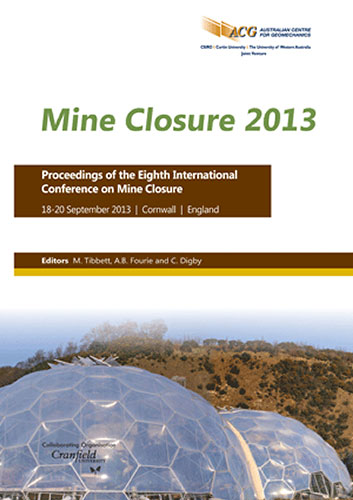Heat extraction from hypersaline mine water at the Dawdon mine water treatment site

|
Authors: Bailey, MT; Moorhouse, AML; Watson, IA |
DOI https://doi.org/10.36487/ACG_rep/1352_47_Bailey
Cite As:
Bailey, MT, Moorhouse, AML & Watson, IA 2013, 'Heat extraction from hypersaline mine water at the Dawdon mine water treatment site', in M Tibbett, AB Fourie & C Digby (eds), Mine Closure 2013: Proceedings of the Eighth International Seminar on Mine Closure, Australian Centre for Geomechanics, Cornwall, pp. 559-570, https://doi.org/10.36487/ACG_rep/1352_47_Bailey
Abstract:
Mine closure needs to take consideration of the potential wider environmental and economic value of the mine infrastructure and surface environs. An area of growing interest in the exploitation of abandoned mine sites as an economic resource is the heat recoverable from mine waters or as a sink for heat from cooling applications. Mine site restorations and redevelopments can benefit from potentially vast quantities of ‘green’ heat energy, facilitated by considered mine abandonment (ensuring open shafts remain secure and monitoring recovery of water levels, for example). Pumping of waters, or engineered gravity outflows from mine workings, are often required post-closure to prevent uncontrolled discharges as water levels rebound; in these cases the water source is readily accessible. Alternatively, viable heating schemes may actively abstract mine water, with a specific objective of recovering heat, before discharging it at surface or re-injecting it into the mine. Mine waters are, however, often characterised as poor quality, with high concentrations of pyrite oxidation products and dissolved solids being typical. While temperatures of mine waters can be favourable for highly efficient heat-pump coupled space heating applications, concerns over damage to heat exchangers due to poor water quality may limit their application. Research has been conducted to assess the impacts of hypersaline and ferruginous mine water on a heat pump system, which could provide large amounts of low-carbon heating at mine site redevelopments. A pilot-scale heat pump has been installed within the Coal Authority’s Dawdon mine-water treatment facility in the northeast of England and has been in operation for more than two years. Flows of ~1L/s of untreated coal mine water containing > 70mg/L iron, and water treated to remove iron to < 1mg/L for environmental purposes, have been passed through heat exchangers coupled to an ‘off the shelf’ domestic heat pump. Space heating and hot water were provided to an office complex that is part of the mine-water treatment facility. Results indicate that water treated to substantially reduce iron concentrations can still cause blockage of heat exchangers with iron oxyhydroxide precipitates. However, in systems isolated from the atmosphere, poor quality untreated water did not cause clogging of heat exchangers in the trial period and thus is not liableto be a significant obstacle for application of commercially available heat exchangers in mine-water-sourced heating schemes. Presented in this paper are the details of the heat pump setup, water quality data and geochemical modelling to demonstrate the importance of a sealed system for the use of raw mine water. On the basis of practical experience, some advice will be provided for mine closure planning in order to facilitate mine-water heating systems in site redevelopments.
References:
Banks, D. (2008) An Introduction to Thermogeology: Ground Sourced Heating and Cooling, Blackwell.
Banks, D. (2009) An introduction to ‘thermogeology’ and the exploitation of ground source heat, Quarterly Journal of Engineering Geology and Hydrogeology, Vol. 42(3), pp. 283–293.
Banks, D., Younger, P.L., Arnesen, R.T., Iversen, E.R. and Banks, S.B. (1997) Mine-water chemistry: the good, the bad and the ugly, Environmental Geology, Vol. 32(3), pp. 157–174.
Banks, D., Skarphagen, H., Wiltshire, R. and Jessop, C. (2003) Mine water as a resource: space heating and cooling via use of heat pumps, Land Contamination & Reclamation, Vol. 11(2), pp. 191–198.
Banks, D., Fraga Pumar, A. and Watson, I. (2009) The operational performance of Scottish minewater-based ground source heat pump systems, Quarterly Journal of Engineering Geology and Hydrogeology, Vol. 42(3), pp. 347–357.
Hall, A., Scott, J.A. and Shang, H. (2011) Geothermal energy recovery from underground mines, Renewable and Sustainable Energy Reviews, Vol. 15(2), pp. 916–924.
Jessop, A.M., Macdonald, J.K. and Spence, H. (1995) Clean energy from abandoned mines at Springhill, Nova Scotia, Energy Sources, Vol. 17(1), pp. 93–106.
Parker, K. (2003) Mine water management on a national scale - experiences from the Coal Authority, Land Contamination & Reclamation, Vol. 11(2), pp. 181–190.
Parkhurst, D.L. and Appelo, C.A.J. (2011) Description of input and examples for PHREEQC version 3—A computer program for speciation, batch-reaction, one-dimensional transport, and inverse geochemical calculations: U.S. Geological Survey Techniques and Methods, Book 6, Chap. A43, 497 p., available only at .
Roijen, E.I.E. (2011) The use of an open-loop heat-pump system to heat social housing and an office building throughout the town of Heerlen, the Netherlands, in Heat Pump Technology Using Minewater, M.L. Faull (ed).
Watzlaf, G.R. and Ackman, T.E. (2006) Underground mine water for heating and cooling using geothermal heat pump systems, Mine Water and the Environment, Vol. 25, pp. 1–14.
Watzlaf, G.R., Kairies, C.L., Schroeder, K.T., Danehy, T. and Beam, R. (2002) Quantitative results from the flushing of four reducing and alkalinity producing systems, in Proceedings The West Virginia Surface Mine Drainage Task Force Symposium.
Wieber, G. and Pohl, S. (2008) Mine water: a source of geothermal energy – examples from the Rhenish Massif, in Proceedings International Mine Water Association Congress, 2-5 June 2008, Karlsbad, Czech Republic.
Wyatt, L.M., Moorhouse, A.M.L., Kershaw, S. and Iwanskyj, B. (2013)Mine water: management post closure and lessons learned; risks from poor closure management and mine water management, in Proceedings Eighth International Conference on Mine Closure 2013 (Mine Closure 2013), M. Tibbett, A.B. Fourie and C. Digby (eds), 18–20 September 2013, Cornwall, UK.
© Copyright 2025, Australian Centre for Geomechanics (ACG), The University of Western Australia. All rights reserved.
View copyright/legal information
Please direct any queries or error reports to repository-acg@uwa.edu.au
View copyright/legal information
Please direct any queries or error reports to repository-acg@uwa.edu.au